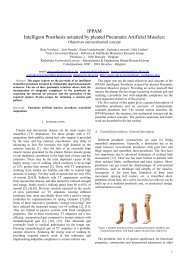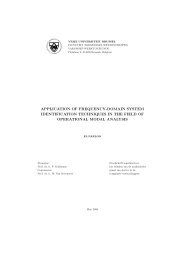VRIJE UNIVERSITEIT BRUSSEL Acoustics - the Dept. of ...
VRIJE UNIVERSITEIT BRUSSEL Acoustics - the Dept. of ...
VRIJE UNIVERSITEIT BRUSSEL Acoustics - the Dept. of ...
Create successful ePaper yourself
Turn your PDF publications into a flip-book with our unique Google optimized e-Paper software.
3.10. MEASURING SOUND SOURCES 553.10.3 The comparison methodIn <strong>the</strong> ’comparison method’ one uses a reference source which is normalised.The method itself is also standardized in many industries. The test is conductedin a so called acoustic hard room, since one does not usually haveaccess to an acoustic dead (anechoic) room. The reference source can generatefor example a power L ′ W . Firstly, one has to install multiple microphonesspaced out in <strong>the</strong> room and not to close to <strong>the</strong> machine (in <strong>the</strong> far field). Onemeasures <strong>the</strong> sound pressure levels L pi and <strong>the</strong> spatial averages L pm <strong>of</strong> <strong>the</strong>sound radiated by <strong>the</strong> unknown source (use Equation 3.12). Secondly, one<strong>the</strong>n replaces <strong>the</strong> machine with <strong>the</strong> reference source and one measures L ′ pm inan identical fashion (microphones on identical positions). In each frequencyband <strong>the</strong> following equations hold true : L W = L pm +C and L ′ W = pm+C L′(where c is a constant that is <strong>the</strong> same for <strong>the</strong> two measurements) The unknownpower can be calculated from :L W = L ′ W +(L pm −L ′ pm ) (3.14)3.10.4 Power measurement with an intensity meterDue to <strong>the</strong> fact that <strong>the</strong> measuring locations for <strong>the</strong> described comparisonmethods are located in <strong>the</strong> far field, that method is not applicable whendifferent objects are placed close to each o<strong>the</strong>r. In this case one can use anintensity meter to measure <strong>the</strong> sound power. The following procedure mustbe used to do this (ISO 9614) :Define a random surface S that includes <strong>the</strong> source. This does not haveto be placed in <strong>the</strong> far field but can be situated close to <strong>the</strong> source.Measure <strong>the</strong> intensity I i in N discrete points on <strong>the</strong> surface S.Calculate <strong>the</strong> power level : L W = 10log ∑ N W ii=1 W 0with W i = I i S i .Instead <strong>of</strong> discrete measuring locations an alternative method can beused where <strong>the</strong> intensity meter scans in a continuous fashion over <strong>the</strong> definedsurface (<strong>the</strong> so called sweep method, described in ISO 9614-2). Care must betaken that <strong>the</strong> sweep speed is as constant as possible, moreover <strong>the</strong> intensitymeter must be held perpendicular to <strong>the</strong> surface.
















